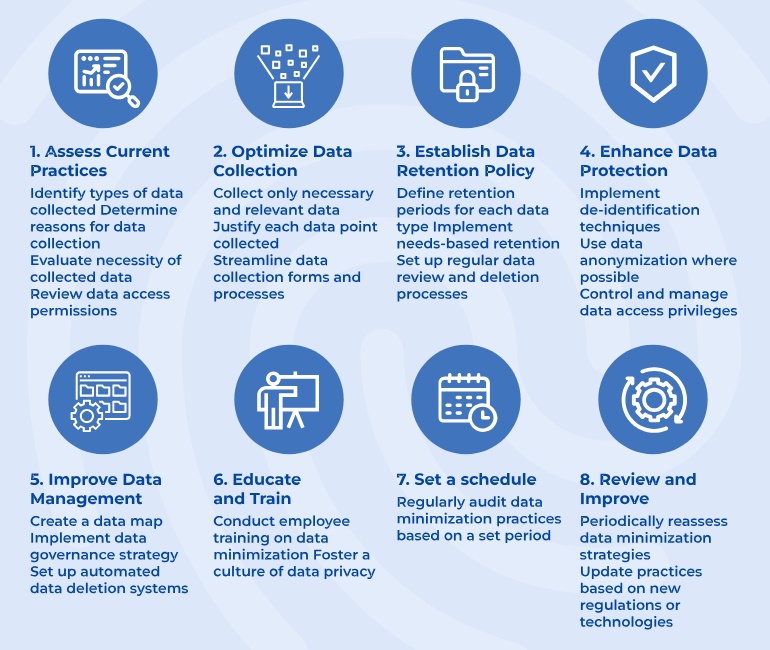Safeguarding personal information online has become more critical than ever as data privacy laws expand and consumers’ expectations grow. One of the most effective strategies for protecting data is through data minimization.
This principle, enshrined in various data protection and privacy laws like the General Data Protection Regulation (GDPR) and the California Privacy Rights Act (CPRA), emphasizes the importance of collecting, processing, and storing only the minimum amount of personal data necessary for a specific purpose, and retaining it only as long as needed to fulfill the stated purpose.
But what exactly is data minimization, how does it work, and how can your company implement measures to limit its data collection in beneficial ways? Let’s delve into it.
What is data minimization?
Data minimization is a fundamental principle in data protection and privacy laws like the General Data Protection Regulation (GDPR).
Data minimization refers to collecting, processing, and storing only the minimum amount of personal information necessary for a specific purpose, and retaining it only as long as needed to fulfill that purpose.
This approach aims to reduce risks associated with companies’ potential privacy overreach, data breaches, and other misuse while helping to ensure compliance with various data protection regulations. It also shows respect for customers by demonstrably limiting data collection and use to only what’s needed, communicated, and consented to.
Organizations implementing data minimization strategies only collect relevant data and retain it for the shortest time possible. They also regularly review, delete, or anonymize unnecessary information.
By adhering to this principle, companies can better protect individual privacy, enhance data security, improve data management efficiency, meet legal requirements, and improve customer experience.
Read about marketing data management now
Data minimization and GDPR
Data minimization is a key principle of the GDPR. It requires organizations to collect and process only the personal data that is necessary for their specified purposes. It explicitly addresses data minimization in Article 5(1)(c) GDPR, which states that personal data shall be: “adequate, relevant and limited to what is necessary in relation to the purposes for which they are processed (‘data minimization’).”
This principle is further reinforced by Article 25 GDPR, which requires that data minimization be applied by default to each specific purpose of data processing. These articles mean that website owners and businesses must identify the minimum amount of personal data required to fulfill their purpose and collect and hold only that information.
To comply with data minimization requirements, organizations should regularly review their data collection mechanisms, like website cookies, what data they collect, and for what purposes. Then they should also review what data they currently store and use, and if the purposes for which the data was collected are still valid. Finally, they should delete or anonymize data that is no longer needed.
By adhering to this principle, organizations can demonstrate accountability and reduce their risk of noncompliance with the GDPR.
Data minimization and CPRA
The California Privacy Rights Act (CPRA) also introduces data minimization as a key principle for businesses handling consumer personal information.
Under the CPRA, businesses are required to collect, use, retain, and share personal information only to the reasonably necessary extent and proportionate to achieve the specific purposes for which it was collected or processed.
Therefore, businesses must clearly define and disclose the purposes for data collection and ensure that the data is not used beyond these purposes without additional consumer notification and consent where required. In addition, the law requires businesses to implement data retention schedules and delete or anonymize (depending on the law or relevant policies) personal information once it is no longer necessary for disclosed processing purposes.
What is an example of data minimization?
Data minimization doesn’t have to be a complicated affair. For example, let’s look at data minimization in action in the context of an ecommerce website’s checkout process.
Instead of collecting extensive personal information from customers, the website could request only the necessary details for completing the transaction and shipping the product. This might include the customer’s email address, to send a receipt and order confirmation; name and shipping address, to send the order; and payment information. The company also receives various data just as part of the ordering process, like that from website cookies that track the customer’s shopping process, and order specifics like which product, size, and color.
In this example, there is no real need to ask for additional data, such as the customer’s date of birth, gender, or occupation, which are not essential for processing the order, even if these details would provide the company with more demographic information about the customer.
By limiting data collection to only what is required, the ecommerce site reduces its data liability and enhances customer privacy, while still effectively fulfilling its primary function of selling and delivering products.
Read about GDPR email marketing now
Benefits of data minimization
Many website owners and companies prefer to collect a lot of data. After all, more data helps you understand your target audience and optimize marketing campaigns. However, this is a poor practice in the age of digital privacy.
While privacy laws like the GDPR and CPRA require businesses to implement data minimization practices, the benefits go beyond regulatory compliance. Additional benefits of data minimization include:
- Reduced costs: Collecting and storing only necessary data significantly lowers storage and management expenses.
- Enhanced security: Collecting less data reduces the potential impact of breaches and theft, leaving less potentially sensitive information at risk.
- Efficient data management: With less data to process, analyze, and prune, organizations can manage their information more effectively, improving operational efficiency.
- Better data quality: Focusing on relevant and necessary data improves the overall quality and accuracy of datasets.
- Reduced risk profile: Minimizing data collection and storage decreases an organization’s risk related to data access and handling.
- Enhanced customer trust: Data minimization shows a commitment to protecting customer privacy, boosting consumer confidence.
- Simplified data governance: Fewer data assets make it easier to implement and maintain effective data governance.
- Faster data processing: Smaller data volumes allow for quicker analysis and decision-making.
The principles of data minimization
Data minimization is a key principle of data privacy regulation, along with closely related ones like maintaining accuracy and purpose limitation. It’s meant to guide organizations in collecting, processing, and storing personal data to fulfill specific purposes, from ecommerce sales to marketing campaigns to product development.
Here are key principles that website owners should follow to reduce their privacy noncompliance risk.
- Clearly define the specific purpose(s) for data collection and use before any personal data is collected. This will inform what data is needed to fulfill the purpose.
- Only collect data that is directly relevant and necessary for a specific purpose. Be extra vigilant if any of the data is typically categorized as “sensitive” or belongs to children, as this often requires additional consent and safeguards.
- Do not repurpose data without necessary notification, justification, and updated consent.
- Collect enough data to fulfill the stated purpose without exceeding what is required.
- Keep personal data only as long as necessary to achieve the specified purpose. Establish and follow data retention policies to delete or anonymize data when it is no longer needed.
- Embed data minimization into the design of systems and processes from the start to ensure privacy protection is built in.
- When possible, anonymize personal data to reduce the risk of identifying individuals, especially for long-term retention or secondary uses.
- Regularly review data collection, processing, and holdings to determine if they remain relevant, or need to be updated or deprecated.
By following these principles, website owners can reduce privacy risks, enhance data security, improve regulatory compliance, roll out more precise marketing initiatives, and build trust with their customers.
Read about Big data marketing now
Data minimization and risk mitigation
Data minimization is a powerful strategy for reducing risks when handling personal information.
By collecting and keeping only essential personal data and cookies, website owners can significantly lessen the impact of potential breaches. This approach simplifies data protection efforts, as there’s less information to safeguard.
From a legal perspective, holding less data means fewer chances of violating privacy laws. This is particularly important given strict regulations like the GDPR. Data minimization brings companies one step closer to complying with these laws, avoiding hefty fines, reputational damage, and legal complications.
There’s also a financial advantage to this approach. Storing and managing large amounts of information can be costly, from both a financial and resource perspective. By cutting down on unnecessary data, companies can save on storage and processing expenses. Not to mention the work of maintaining or expunging it, or finding all of it to fulfill a data subject access request, for example.
In the event of a data issue, having less information to sort through enables quicker response times and a higher likelihood of accuracy. This rapid action can help limit damage and preserve customer trust.
Moreover, data minimization demonstrates respect for customer privacy. By only requesting and retaining necessary information, businesses can build stronger, more trusting relationships with their clients. This practice not only protects the company but also enhances its reputation in an increasingly privacy-conscious market.
How to implement data minimization measures

Data minimization may sound simple, but in practice, companies must consider how they collect, use, store, and dispose of customer data. In addition to being prepared to do the work to update policies, processes, and the management of the data itself.
Thus, if your company is considering implementing a data minimization policy, there are certain steps you need to follow.
- Assess your current data practices: Evaluate how your organization currently collects, retains, and manages access to personally identifiable information. This involves:
- identifying what types of data are being collected
- determining how long the organization has had the data
- determining why each piece of data is being collected
- evaluating if the collected data is necessary for the stated purpose
- reviewing who has access to data (e.g. third-party vendors) and what they may be doing with it
- review where data is stored (e.g. in various departments) and who has access
- Implement proportional data collection: Only collect data that is proportional and relevant to the purposes for which you are collecting it. Justify why you collect, process, or store consumer data and ensure these purposes align with your current business and data privacy objectives.
- Establish needs-based retention: Develop a strict data retention policy that ensures your business only retains data needed for specific purposes and only for as long as necessary. Once these purposes are met or the required retention period has passed, the data should be deleted.
- Use data anonymization techniques: When possible, anonymize data to protect individual privacy while still allowing for necessary data processing.
- Control data access: Implement a system that enables secure management of data access privileges across your organization. This ensures that only specific applications or individuals have access to the data fields required for their business processes.
- Regularly review data and delete unnecessary information: Establish procedures to periodically review the data your organization processes and the purposes for it, and remove anything that is no longer necessary to fulfill its original purpose. Consider implementing an automated solution that deletes certain data at predefined intervals.
- Define data retention schedules: Set specific retention periods for each type of data your website and company processes. This should be part of your overall data map and governance strategy.
- Streamline data collection processes: Review your data collection methods and forms to ensure you’re only asking for essential information. For example, if you only need a customer’s email for communication, don’t ask for their phone number or physical address.
By following these steps, website owners can effectively implement data minimization, enhance protection, reduce risks, and build customer trust.
Collect less to build consumer trust
Data minimization is not just a regulatory requirement, but a fundamental practice that can transform how organizations handle personal information.
By collecting only what is necessary, website owners can visibly demonstrate dedication to data security, user privacy, and respect for users’ rights under privacy regulations. The principles of data minimization, as outlined in regulations like GDPR and CPRA, offer a clear framework for organizations to follow, helping companies achieve and maintain compliance.
As digital privacy concerns continue to grow, adopting data minimization practices will be crucial for any organization aiming to maintain its reputation and safeguard its stakeholders’ information.




